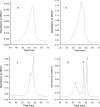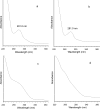Chelation of Cu(II), Zn(II), and Fe(II) by tannin constituents of selected edible nuts
- PMID: 20054482
- PMCID: PMC2802006
- DOI: 10.3390/ijms10125485
Chelation of Cu(II), Zn(II), and Fe(II) by tannin constituents of selected edible nuts
Abstract
The tannin fractions isolated from hazelnuts, walnuts and almonds were characterised by colorimetric assays and by an SE-HPLC technique. The complexation of Cu(II) and Zn(II) was determined by the reaction with tetramethylmurexide, whereas for Fe(II), ferrozine was employed. The walnut tannins exhibited a significantly weaker reaction with the vanillin/HCl reagent than hazelnut and almond tannins, but the protein precipitation capacity of the walnut fraction was high. The SE-HPLC chromatogram of the tannin fraction from hazelnuts revealed the presence of oligomers with higher molecular weights compared to that of almonds. Copper ions were most effectively chelated by the constituents of the tannin fractions of hazelnuts, walnuts and almonds. At a 0.2 mg/assay addition level, the walnut tannins complexed almost 100% Cu(II). The Fe(II) complexation capacities of the tannin fractions of walnuts and hazelnuts were weaker in comparison to that of the almond tannin fraction, which at a 2.5 mg/assay addition level, bound Fe(II) by approximately 90%. The capacity to chelate Zn(II) was quite varied for the different nut tannin fractions: almond tannins bound as much as 84% Zn(II), whereas the value for walnut tannins was only 8.7%; and for hazelnut tannins, no Zn(II) chelation took place at the levels tested.
Keywords: Cu(II); Fe(II); Zn(II); almonds; hazelnuts; metal chelating capacity; tannins; walnuts.
Figures





Similar articles
-
Limitations of the tetramethylmurexide assay for investigating the Fe(II) chelation activity of phenolic compounds.J Agric Food Chem. 2009 Jul 22;57(14):6425-31. doi: 10.1021/jf901100t. J Agric Food Chem. 2009. PMID: 19537796
-
Bioaccessibility of Cd, Cu, Fe, Mn, Pb, and Zn in hazelnut and walnut kernels investigated by an enzymolysis approach.J Agric Food Chem. 2013 Jun 26;61(25):6086-91. doi: 10.1021/jf401816j. Epub 2013 Jun 17. J Agric Food Chem. 2013. PMID: 23738954
-
Evaluation of Cadmium, Lead, Chromium, and Nickel Content in Various Types of Nuts: Almonds, Cashews, Hazelnuts, Peanuts, and Walnuts - Health Risk of Polish Consumers.Biol Trace Elem Res. 2025 Jul;203(7):3913-3930. doi: 10.1007/s12011-024-04438-4. Epub 2024 Nov 6. Biol Trace Elem Res. 2025. PMID: 39500833 Free PMC article.
-
Edible Nuts for Memory.Curr Pharm Des. 2020;26(37):4712-4720. doi: 10.2174/1381612826666200806095649. Curr Pharm Des. 2020. PMID: 32767923 Review.
-
Almond, hazelnut and walnut, three nuts for neuroprotection in Alzheimer's disease: A neuropharmacological review of their bioactive constituents.Pharmacol Res. 2018 Mar;129:115-127. doi: 10.1016/j.phrs.2017.12.003. Epub 2017 Dec 5. Pharmacol Res. 2018. PMID: 29208493 Review.
Cited by
-
Phyllanthus emblica (Amla) Fruit Powder as a Supplement to Improve Preweaning Dairy Calves' Health: Effect on Antioxidant Capacity, Immune Response, and Gut Bacterial Diversity.Biology (Basel). 2022 Dec 1;11(12):1753. doi: 10.3390/biology11121753. Biology (Basel). 2022. PMID: 36552263 Free PMC article.
-
Therapeutic potential of synthetic and natural iron chelators against ferroptosis.Naunyn Schmiedebergs Arch Pharmacol. 2025 Apr;398(4):3527-3555. doi: 10.1007/s00210-024-03640-4. Epub 2024 Nov 27. Naunyn Schmiedebergs Arch Pharmacol. 2025. PMID: 39601820 Review.
-
Disruption of signaling in a fungal-grass symbiosis leads to pathogenesis.Plant Physiol. 2010 Aug;153(4):1780-94. doi: 10.1104/pp.110.158451. Epub 2010 Jun 2. Plant Physiol. 2010. PMID: 20519633 Free PMC article.
-
The antioxidant and anti-inflammatory effects of Carica Papaya Linn. seeds extract on CCl4-induced liver injury in male rats.BMC Complement Med Ther. 2021 Dec 30;21(1):302. doi: 10.1186/s12906-021-03479-9. BMC Complement Med Ther. 2021. PMID: 34969385 Free PMC article.
-
Transcriptome analysis reveals molecular anthelmintic effects of procyanidins in C. elegans.PLoS One. 2017 Sep 19;12(9):e0184656. doi: 10.1371/journal.pone.0184656. eCollection 2017. PLoS One. 2017. PMID: 28926584 Free PMC article.
References
-
- Halvorsen BL, Holte K, Myhrstad MCW, Barikmo I, Hvattum E, Remberg SF, Wold AB, Haffner K, Baugerod H, Andersen LF, Moskaug JO, Jacobs DR, Blopmhoff R. A systematic screening of total antioxidants in dietary plants. J. Nutr. 2002;132:461–471. - PubMed
-
- Blomhoff R, Carlsen MH, Andersen LP, Jacobs DR., Jr Health benefits of nuts: potential role of antioxidants. Brit J Nutr. 2006;96:S52–S60. - PubMed
-
- Yurttas HC, Schafer HW, Warthesen JJ. Antioxidant activity of nontocopherol hazelnut (Corylus spp.) phenolics. J Food Sci. 2000;65:276–280.
-
- Wijeratne SSK, Abou-Zaid MM, Shahidi F. Antioxidant polyphenols in almond and its coproducts. J. Agric. Food Chem. 2006;54:312–318. - PubMed
-
- Alasalvar C, Karamać M, Amarowicz R, Shahidi F. Antioxidant and antiradical activities in extracts of hazelnut kernel (Corylus avellana L.) and hazelnut green leafy cover. J Agric Food Chem. 2006;54:4826–4832. - PubMed
Publication types
MeSH terms
Substances
LinkOut - more resources
Full Text Sources
Other Literature Sources
Medical

